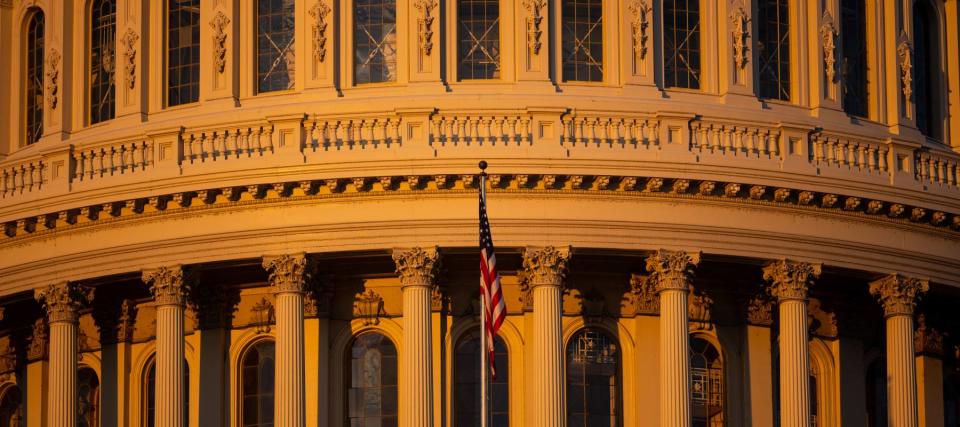'Truly depressing achievement': US hits record $34 trillion national debt — more than the value of China, Japan, Germany, India and the UK's economies combined. What does this mean for you?

America’s national debt eclipsed $34 trillion for the first time in history.
Data from the Treasury Department shows the nation’s total outstanding debt passed the milestone figure on Dec. 29, only months after it had reached $33 trillion.
Don't miss
Commercial real estate has outperformed the S&P 500 over 25 years. Here's how to diversify your portfolio without the headache of being a landlord
Take control of your finances in 2024: 5 money moves to start the new year off strong
The US dollar has lost 87% of its purchasing power since 1971 — invest in this stable asset before you lose your retirement fund
A debt of $34 trillion is more than the combined GDP of the top five global economies after the U.S. — China ($17.9 trillion), Japan ($4.2 trillion), Germany ($4.0 trillion), India ($3.4 trillion) and the United Kingdom ($3.0 trillion) — according to the World Bank.
Total U.S. debt has more than doubled 2013 and is up nearly $3 trillion since the government suspended the debt ceiling in June — averting what would have been a first-ever default with just two days to spare.
Now, the U.S. is spending nearly $2 billion per day on interest payments alone, according to the Peter G. Peterson Foundation. With lawmakers in Washington facing imminent deadlines for new federal funding plans, the nation’s economic woes may be set to continue well into 2024.
“Though our level of debt is dangerous for both our economy and for national security, America just cannot stop borrowing,” Maya MacGuineas, president of the Committee for a Responsible Federal Budget, said in a statement — adding that the new record high is “a truly depressing ‘achievement.’”
What's driving the deficit?
America's growing debt problem is the result of a mismatch between federal spending and revenues.
The Peter G. Peterson Foundation, a nonpartisan organization dedicated to addressing America’s long-term fiscal challenges, attributes the federal budget deficit to “predictable structural factors” that include:
The aging baby boomer generation — which is putting pressure on vital programs that serve older and vulnerable Americans, such as Social Security, Medicare, and Medicaid;
Rising health-care costs, which are among the fastest-growing in the U.S. budget; and
Inadequate tax revenues, which are not bringing in enough money to pay for what the government has promised U.S. citizens.
The federal government did take steps to address the budget deficit in 2023 — primarily through the passing of the bipartisan Fiscal Responsibility Act (FRA) in June. This law approved two years of spending caps (especially on non-defense discretionary items like domestic law enforcement, forest management, scientific research and more), additional work requirements for government benefits like food stamps, and cuts to IRS funding.
Read more: Find out how to save up to $820 annually on car insurance and get the best rates possible
“There is some good news: 2023 was actually a good year for fiscal responsibility, where we saw a net $1.3 trillion improvement in the 10-year deficit picture, largely thanks to the bipartisan Fiscal Responsibility Act,” MacGuineas said. “That’s a decent down payment on the much-needed deficit reduction it will take to stem the rise in our national debt.
“But as we enter 2024, there is a huge risk we will return to making things worse by adding new tax cuts, spending increases, and/or ignoring the caps agreed to in the FRA.”
What's next?
Under the FRA, the national debt ceiling will remain uncapped for 2024, kicking the fight over the nation’s debt load — and any long-term solutions — to 2025, past the upcoming presidential election. Until then, there are many pressing fiscal issues for Washington to figure out.
What happens next is critical. Two federal spending laws are set to expire on Jan. 19 and Feb. 2, but lawmakers remain at loggerheads on how to pass full-year spending bills or more temporary funding.
If they fail to reach an agreement by Jan. 19, the government would slide into a shutdown as funds for programs run dry.
But what could the ongoing debt challenges mean for the average consumer?
Apart from funding for important programs — such as Social Security and those related to health care — outstripping tax revenues, Shai Akabas, director of economic policy at the Bipartisan Policy Center told The Associated Press: “It could mean spikes in interest rates, it could mean a recession that leads to lots more unemployment. It could lead to another bout of inflation or weird goings on with consumer prices — several of which are things that we've experienced just in the past few years.”
What to read next
This Pennsylvania trio bought a $100K abandoned school and turned it into a 31-unit apartment building — how to invest in real estate without all the heavy lifting
Jeff Bezos and Oprah Winfrey invest in this asset to keep their wealth safe — you may want to do the same in 2024
Rising prices are throwing off Americans' retirement plans — here’s how to get your savings back on track
This article provides information only and should not be construed as advice. It is provided without warranty of any kind.

 Yahoo Finance
Yahoo Finance 